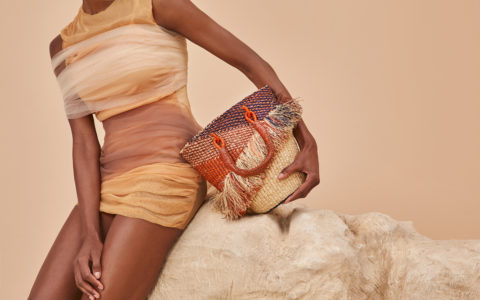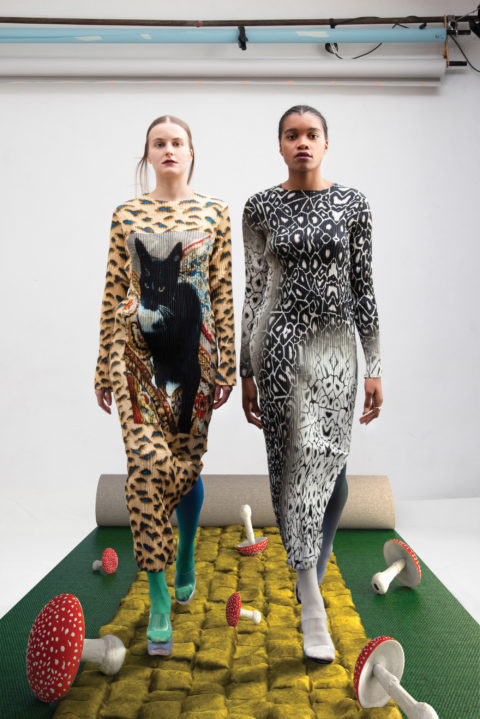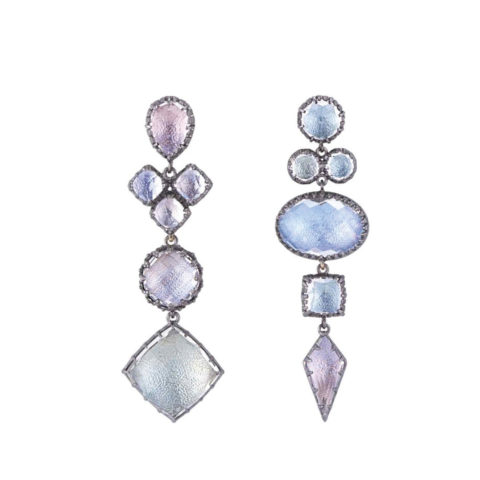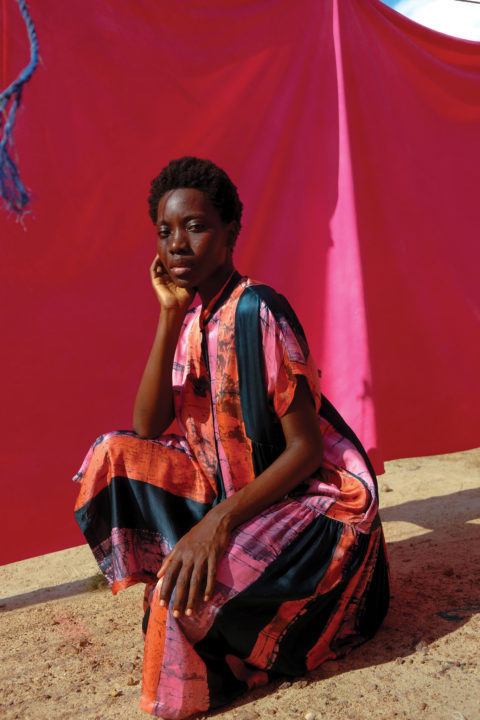Odessa Paloma Parker reveals a selection of labels that give “luxury” a more intentional meaning.
AAKS

Akosua Afriyie-Kumi launched her line of vibrant hand-woven accessories after moving from Ghana to the United Kingdom and studying fashion design. “It was difficult to find a job after,” she says. The industry was saturated with hopefuls, and fast fashion still dominated. “I always wanted to start my own brand, but I didn’t know which direction to go in,” says Afriyie-Kumi. “I remembered that when I was a child in Ghana, we had lots of baskets. You would see a lot of weavers selling their handicrafts on the roadside. I started thinking ‘Why hasn’t anybody done something new with this?’ That was my light-bulb moment – to focus on this craftsmanship and these ideas and turn them into something someone in London or New York or Spain would appreciate.”
With some motherly nudging – “My mom would visit me in London and say ‘Why don’t you come back to Ghana?’” – Afriyie-Kumi began to formulate the idea for AAKS. “I started looking for weavers in the South,” she recalls of her return to her native roots.
“Through research, I realized that most basket weavers are based in the North.” After making the 10-hour trek, Afriyie-Kumi was able to connect with talented makers, and her team has grown from three to 30 as AAKS has caught the attention of an international audience. Mere months after the label’s launch, multi-brand retailer Anthropologie reached out to Afriyie-Kumi to carry her wares, and now AAKS can be found in various stores worldwide. A collaborative tote with the hip ready-to-wear label Rag & Bone launched in August.
It’s all a heady departure from AAKS’s humble beginnings. “I spent about two years under a tree, working with the weavers and developing my samples,” says Afriyie- Kumi. “Of course, it sounds so easy talking about it now, but it was so hard to begin. There was a language barrier, and trying to get my ideas into 3-D with the weavers was difficult. I was trying to do something a bit different.”
Weaving in Ghana goes back thousands of years. “I’m still doing research into how it all began and why it’s done,” she says. “When I speak to my weavers, they tell me it’s something they’ve been doing since they were young. Your dad is a weaver, your mom is a weaver, so you weave as a little kid. All the kids in the community can weave, but with training, they can weave something of a higher standard.”
Afriyie-Kumi has achieved such prowess in developing this kind of infrastructure that she was tapped to participate in the launch of a training program started by the United Nations High Commissioner for Refugees and has since become a partner in the initiative. “They saw my work and thought ‘Perfect,’” she says. “I was working with weavers already so I could help them set up this new program.” The result was AAKS’s Weaving for Change line of home decor items.
Afriyie-Kumi acknowledges that her collaborative approach is time-consuming—even parallel to that of creating an haute couture gown. “In general, it takes about a week to make one product,” she says. “First, we have to source the fibres and transport them to the weavers – it takes three days or more before they even get the raw materials. They twist them, dye them and dry them. Then they begin to weave.”
Products are sent to AAKS’s studio for finishing before they are dispatched to a growing legion of fans. “Before I moved back to Ghana, there was a lot of talk about fast fashion,” says Afriyie-Kumi about what differentiates her designs – ones that have resonated even more greatly, she notes, since the Black Lives Matter movement felt a groundswell this summer. “I always remember that I never wanted to go into that market. I wanted to do something that was handmade. This is where my story began.”
Julia Heuer

Trained as a textile designer, Julia Heuer first learned about the Japanese dyeing technique of Arashi Shibori when she was an exchange student in Copenhagen. She was drawn to its simplicity and nearly instant gratification. “It’s exactly how I like to work,” says the Germany-based creative. “It offers very quick results, but it’s handmade.” It also affords Heuer and her team the ability to work in a satisfyingly-scaled-back way. “You just need a tube for wrapping the fabric and you can dye it in hot water,” she describes. No expensive industrial-sized equipment is needed.
Heuer’s adoption of Arashi Shibori (which was developed by Kanezo Suzuki as a way to create an all-over pattern on fabrics and is an innovation of the ancient Shibori method used as far back as the 8th century) means that she’s free from having a strong reliance on suppliers – and that’s certainly helpful given the global limitations on manufacturing and shipping presented by COVID-19 this year. “when you’re a textile designer, you usually depend on other companies to produce materials,” she explains. “with this technique, i can do it in my studio – I’m able to do it with my own two hands.”
The designer’s fall collection, titled Funny Animals, draws inspiration from the array of natural prints found on all manner of creatures. Heuer’s offbeat pieces combine digital prints and hand-painted fabrics, and there’s a moment of truth when you see how these effects are realized after the fabric has been given the Shibori treatment. “You have to see if the print works after pleating,” she says of the union between the hand-hewn plissé material and its artistic treatments. “When they work together, they create something new and give the resulting product a certain dynamic that makes it feel immediately right.” Sounds like the ideal kind of fast fashion.
Blu HummingBird Beadwork

“Beading is medicine,” says Brit Ellis, founder of accessory line Blu Hummingbird Beadwork. “It teaches and connects us.” Ellis started her practice after joining a beading circle facilitated by George Brown College in Toronto while she was a student there. “I grew up displaced from community,” says Ellis, who had virtually no ties to her Indigenous background while growing up. “When I was in college, I attended beading circles at the Friendship Centre. I felt a real connection with beading almost immediately.”
Ellis started her brand in 2014, and her creations incorporate both contemporary motifs (cartoon characters, the Toronto Raptors logo) and ones linked to her ancestry – her Moon Medallion pieces are particularly popular. “I’ve always felt really connected to the moon,” she says about why she began crafting the labour-intensive pieces, which can take up to 30 hours to complete. “And I wanted to do beadwork with moon imagery since I started.” Ellis’s attachment to lunar activity and its symbolic link to life cycles has a deeply personal resonance. “I struggled with infertility for about six years; I got very sick and had emergency surgery to remove one of my ovaries,” she explains. “It was a very confusing time. The teachings around Grandmother Moon really helped me feel grounded and connected. They helped me feel hopeful. The cycle and the renewal – it’s all very powerful to me.”
Ellis has explored other deeply intimate motifs in her beading, from human hearts to vulvas. “I’ve beaded a number of them,” she says, adding that many Indigenous community members have “received negative feedback when talking about sexuality and our bodies.” She says she feels fortunate that that has not been her experience. “When I was speaking with my elders about the vulva pieces, I got very positive feedback.”
Bridging generational traditions and practices with contemporary concepts is something Ellis finds deeply gratifying about her beading.
“My Indigeneity is tied to the past, present and future,” she says. “It’s all intertwined. So I memorialize the things that are of interest to me – like my appreciation for the art of drag – in a modern respect. Those things are just as valid an influence. They are a way for me to fully encompass and express – in a full-circle kind of way – my entire self as a Haudenosaunee woman.”
Larkspur & Hawk

“My love of foiling came from my love of antique jewellery,” says New York-based curator turned jewellery entrepreneur Emily Satloff, who founded her line of fine baubles in 2008. Satloff collects what she describes as more “esoteric” jewellery from as far back as 250 years ago, and she has become familiar with the technique of foiling, which involves “lining a closed setting with brightly hued, gold or silver metallic foils.” She was so bewitched by the effects – describing the interplay of light and colour as a “halo”—that she eventually decided she wanted to find a way to interpret the under- recognized technique in an updated way.
Satloff began to educate those who were curious about her antique foiled jewellery. “The more I heard myself talking about it, the more I had a burning private desire to design a bit of it for myself,” she says. But the revitalization of an antiquated technique requires plenty of research, and that wasn’t easy to do with this near-obsolete craft. “There’s no guidebook or recipe for foiling,” she says. “But I had been working with antique jewellery for so long and had seen it in all stages of disrepair, so I basically had a sense of the ways in which people were foiling 200 years ago.”
Satloff says that after she gained a sense of the basics behind the technique, she “played around with faceted gemstones and candy wrappers to see the effects” until she got the cut she was really looking for and then searched for a jeweller who was patient enough to work with her. She describes the foiling technique as “extremely laborious” and notes that because Larkspur & Hawk is a pioneering brand in terms of modernizing the practice, she – once a student – has essentially become a teacher. “Even today, when I start with a new workshop, I train the artisans on how to do things our way,” she says. “It’s not something they’re versed in…. One of the good things about working with an outdated art form is that we don’t have a lot of competition. But with the benefit of leading the way in modern foiling comes the disadvantage of it not featuring a mainstream technique that people immediately know about.”
This lack of awareness means there’s a steep learning curve for Satloff when it comes to customer education. “There is a misunderstanding of whether it’s fine or fashion jewellery, and it’s all fine,” she notes. “We use fine materials, and the pieces are handmade.” Satloff also wants to make it clear that she’s not replicating pieces from days gone by. “I never want to appear to be doing reproductions,” she adds. “If our work is mistaken for a Georgian piece of jewellery, I’ve done my job poorly.”
Osei-Duro

Founded by Maryanne Mathias and Molly Keogh in 2011, this line of contemporary essentials was inspired by Mathias’s travels to various regions of Africa and India – locales she visited while on hiatus from her former fashion label, Hastings and Main. “After getting frustrated with the design industry and wanting a break, i ended up travelling around the world and designing capsule collections in textile-rich countries,” she says. Upon returning to Canada, Mathias recruited Keogh to join her in launching Osei-Duro.
The brand primarily offers hand-printed batik clothing – pieces that are made by local artisans in Accra. (Mathias is based in her native Vancouver, and Keogh resides in Ghana.) Batik is an ancient wax dyeing technique that cultures across Africa, India and Asia have been employing for centuries as a means of creating artful garments and accessories.
“It takes a while for any designer or artist to find their voice,” notes Mathias. “We have experimented with so many different techniques over the years – natural indigo, plain dye, hand-weaving, factory-dyed fabrics, knits and more – and through feedback and experience, we found that batik was the aesthetic that shone through.”
To better educate customers about the labour involved in making an Osei-Duro garment and to give a face to the makers honouring their local artisan culture, the company boasts a stories pillar on its website. “Our brand is so process-driven; it’s one of the most exciting elements about it,” says Mathias. “The story behind the clothes can almost tell itself.”